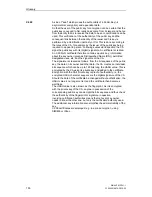
Glossary
SINAUT MD741-1
C79000-G8976-C236-05
149
TCP/IP (Transmission
Control
Protocol/Internet
Protocol
Network protocol that is used to connect two computers on the
Internet.
IP is the basic protocol.
UDP builds on IP, and sends individual packets. These can arrive at
the recipient in a different sequence from the one they were sent in, or
they can even get lost.
TCP serves to secure the connection, and ensures, for example, that
the data packets are forwarded to the application in the right
sequence.
UDP and TCP provide, in addition to the IP addresses, port numbers
between 1 and 65535, which can be used to distinguish the various
services.
A number of additional protocols are based on UDP and TCP, such as
HTTP (Hyper Text Transfer Protocol), HTTPS (Secure Hyper Text
Transfer Protocol), SMTP (Simple Mail Transfer Protocol), POP3 (Post
Office Protocol, Version 3), DNS (Domain Name Service).
ICMP builds on IP, and contains control messages.
SMTP is an e-mail protocol based on TCP.
IKE is an IPsec protocol based on UDP.
ESP is IPsec protocol based on IP.
On a Windows PC, WINSOCK.DLL (or WSOCK32.DLL) handles both
of these protocols.
(
Datagram)
UDP
See TCP/IP
VPN (Virtual Private
Network)
A
V
irtual
P
rivate
N
etwork (VPN) connects several separate private
networks (subnets) via a public network, e.g. the Internet, to form a
shared network. Confidentiality and authenticity are ensured by using
cryptographic protocols. A VPN therefore provides an inexpensive
alternative to dedicated lines when it comes to setting up a
supraregional corporate network.


































